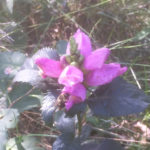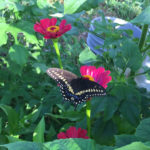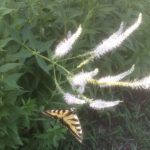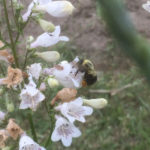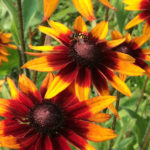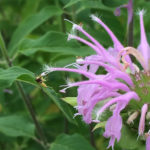What plants should you select for your pollinator garden?
Choose native plants that match your site
Native pollinator plants have co-evolved with native pollinators

The most successful pollinator habitat comprises native wildflowers that serve and are served by native insects—they have evolved together for the conditions that exist where you live. In too many cases, native plants have been replaced by manicured lawns (not native and of zero benefit to pollinators) that are sprayed to kill dandelions and white clover (these are both fantastic and necessary bee plants). Often, in these picture-perfect spaces, native plants have been cleared to make room for ornamental plants, which have lovely fancy flowers that are of no benefit to the creatures who need nectar and pollen to survive. Or native plants are mowed down before they ever get to their flowering and seed stage, and insects starve.
Plant un-sprayed wildflowers for the most beneficial native habitat. In some cases, a plant may be native to the U.S., but not native to your region—in other words, it has not been found in the wild there. This should not prevent you from planting the species, necessarily, as a non-native plant can be very beneficial and you may be helping a plant shift territory in a changing climate. You can research native status for a plant at the USDA Plant data base.
Re-emerging February 2024 our Pollinator Garden Planning Deck
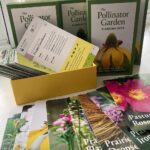 We invented this deck for our farm customers in 2022, and now it’s being sold widely. It’s a fun tool that makes it easier to add plants that provide nectar, pollen, and housing for a range of pollinators. Our deck features 105 wildflowers, shrubs, and grasses (most are native perennials) whose nectar and pollen nurture a range of pollinators. Each plant card features a full-color photo of the flower and describes size, color, growing conditions, planting considerations, pollinators nourished, and special qualities–105 different pollinator plants! Our publisher upgraded the deck to an elegant box.—CLICK this link to order your deck!
We invented this deck for our farm customers in 2022, and now it’s being sold widely. It’s a fun tool that makes it easier to add plants that provide nectar, pollen, and housing for a range of pollinators. Our deck features 105 wildflowers, shrubs, and grasses (most are native perennials) whose nectar and pollen nurture a range of pollinators. Each plant card features a full-color photo of the flower and describes size, color, growing conditions, planting considerations, pollinators nourished, and special qualities–105 different pollinator plants! Our publisher upgraded the deck to an elegant box.—CLICK this link to order your deck!
Determine the characteristics of your garden site
Soil will have a combination of elements:
poor, rocky, gravelly, sandy, shallow, average, rich, humusy, well-drained, or clay
Sun conditions change throughout the day:
full sun, part sun, part shade, full shade
Water in the soil is the third key element:
dry, medium, wet
Consider bloom times
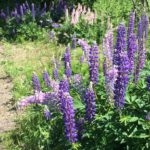
Because native pollinators overwinter on-site, they will require nectar and pollen as soon as they emerge in the spring (April, in Massachusetts)—until they snuggle into the ground at the very end of the season (November). Perennials, which have established root systems, will re-grow earlier in the spring than you can transplant new annuals in the warming garden. We find it most challenging to find early-blooming plants. On our farm, it’s the fruit trees and pussy willows that bloom first, and also the dandelions and Dutch white clover, followed by allium, lupine, columbine, baptisia, amsonia, zizia and spiderwort. By late June, the garden is in full swing.
Provide at least three different flower species for each part of the season (early, middle, late), and plant at least three of each of those flowers (so a minimum of 9 early-blooming plants, 9 middle-blooming plants, and 9 late-blooming plants). Plant Dutch white clover in your lawn, and let the dandelions grow.
Select color and height

Pollinator plants range from 10-inch tall ground covers to 10-foot tall Joe Pye weed and Maximilian sunflowers. Think about placing the tallest plants on the north side of the garden (in our region, the sun shines from the south), so they will not block the sun for lower plants—unless you are planting shorter plants that will welcome part shade, especially protection from the harsh afternoon summer sun. Low plants will provide shade for the roots of the taller plants. In general, smaller plants will have shallower root systems than much larger plants, and so the plants can coexist nicely without competing for soil nutrients.
Pollinator plants are wildflowers. They want to grow. They will adapt. They are not very picky. Many will gradually find other spots in your habitat (they will “naturalize”), and will thrive where the conditions meet their needs. Let them spread.
In general, bees prefer (but are not limited to) blue, white, pink, purple, and yellow blossoms; Monarchs love flat, orange, red, and pink flowers; and hummingbirds prefer red, and also tubular-shaped flowers. But they are not limited to these colors and shapes.
Include Monarch butterflies in your planning

We encourage everyone to include milkweed in your pollinator habitat. We grow four types, and sell two online as seeds. Milkweed is the only plant on which Monarchs lay their eggs. Milkweed used to be plentiful, along roadsides and the edges of farms, but this plant has been obliterated by industrial farming and highway mowing. This easy-to-grow plant is beloved by bees as well. Plant lots of it! Monarch populations have declined by as much as 90%, some say. You’ll find milkweed (Asclepias incarnata and Asclepias syriaca) in our store.
Grow herbs

Pollinators love most culinary herbs. Grow them near your kitchen door for your own use, and leave 50% of them for the bees—let them bloom!
A good rule of thumb is: Leave 50% of what you plant for other creatures.
We plant parsley, basil, and dill as companion plants for tomatoes and lettuce. These are host plants for the Swallowtail butterfly. Catnip is beloved not only by cats, but also by bees.
Grow sunflowers
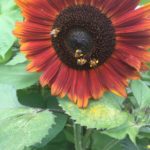
Every pollinator loves sunflowers! There is one perennial sunflower, Maximilian sunflower. The rest are fast-growing annuals. They provide oodles of pollen, seeds for birds, and when the flower heads flop over, the backs of the heads catch water just like a birdbath. If you look at the center of a sunflower, you will see the pattern of the Nautilus shell and the hurricane. This is one of nature’s most common patterns, and is described in math as the Fibonacci series (most efficient).
Grow clumping grasses
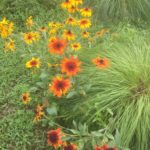
Clumping grasses have a dense base and form a beautiful mound. We planted these grasses to mark the ends of beds that flank paths through our pollinator garden.
The result is a protected environment underneath that is heavenly for ground-nesting pollinators and spiders. Green during the summer, Sporobolus heterolepis turns a gorgeous red and yellow in the fall.
Where can I buy native pollinator plants?
Look online for a local nursery, and ask them if they sell “unsprayed native plants.” Most nurseries, and for sure most big-box stores, sell plants that have been treated with pesticides. Therefore, they will harm native pollinators. A colleague of ours did a survey of over 40 local nurseries, and found only a few that sell unsprayed plants. Visit your local farmer’s market, where you can talk to the grower.
Arriving on shelves across the country as of February 27, 2024: our Pollinator Garden Planning Deck
—CLICK this link to get your Pollinator Garden Planning Deck!
Pollinator Habitat Seeds
We offer collections of our own seeds in our online store. We have grouped different flower varieties to make it easy for you to comply with our guidelines for successful pollinator habitat. The seeds we sell were grown and harvested by us, by hand at That’s A Plenty Farm & Pollinator Habitat. Order your seeds online, in our store.
Links
There is a great selection of heirloom sunflower seeds and zinnia seeds (both are annuals) at Baker Creek Heirloom Seed Company.
Another online source we love, for perennial seeds, is Prairie Moon Nursery.
You can research plant characteristics in the USDA Plant Database.
Pollinator Habitat Plants & Seedlings
If you are LOCAL, and want to visit the farm to pick up some plants (no shipping), we will have seedlings in June. Contact us to check inventory, or to set an appointment: thatsaplentyfarm@gmail.com
or call Cathy’s cell: 413.559.9551

